Grapes And Onions
/5 Comments/in Fruit, Gardening, Pests, Vegetables/by Lee ReichSo Many Choices, In Grapes
With over 5,000 varieties of grapes from which to choose, how can anyone decide which to grow? For better or worse, that choice is naturally limited by climate and pests in each part of the country. Here in the northeast, major limitations are humid summers that spread indigenous disease and frigid winter temperatures.
There’s still plenty of grape varieties from which to choose, which I’ve done over the years, weeding out varieties that would succumb to cold or disease. My varietal possibilities are further limited by my low lying land close to acres upon acres of forest. Cold, moisture-laden air sinks into this low spot, and the abundance of wild grapes clambering up forest trees provide a nearby reservoir of insects and disease spores.
With all that, I want to grow varieties that taste good to me (fresh, not for wine). I have dairy farmer-cum-grape breeder Elmer Swenson to thank for many of the delectable varieties that bear well here, and that I would recommend to others. His Somerset Seedless was ripe back in August, as was his seeded Swenson Red. Right now, the seeded variety Brianna — one of my favorites for flavor — is just finishing, just after Edelweiss and Lorelei.

Swenson Red Grape
Edelweiss has the strong, “foxy” flavor characteristic of American-type grapes, so is not for everyone. That flavor is most familiar in the well-known variety Concord, originated by Ephraim Bull in Concord Massachusetts over 150 years ago. I finally got around to planting a Concord vine a few years ago, and finally decided this year, despite my affinity for grape foxiness, that I didn’t like Concord’s flavor.
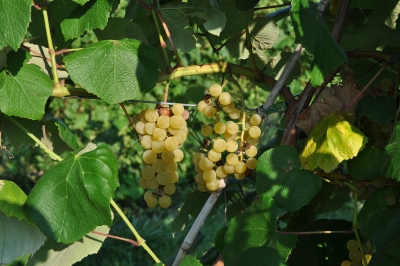
Edelweiss grape
Mr. Swenson isn’t responsible for all my favorite grapes. There’s Alden, with a nice, meaty texture to go with its distinctive flavor. And two excellent, seedless grapes: Glenora and Vanessa. I’m going to rip Concord out of the ground, as well as Cayuga White, which also didn’t make the flavor cut, and Mars, which gets too much disease, and replace them with additional vines of Glenora and Vanessa. The jury is still out on Wapanuka, Reliance, and NY Muscat.

Concord grape
All my “keeper” varieties bear reasonably well and are bursting with distinctive, delicious flavors such that I cannot, even when grape season has passed, bring myself to eat the relatively flavorless varieties generally offered from supermarket shelves.
Rotting Onions
How are your onions holding up? Mine, not so well. I knew that the giant Ailsa Craig onions weren’t keepers. But they shouldn’t be already turning soft and smelly.
Some sleuthing uncovered the culprits: the bacteria, Pantoea agglomerans and/or its cousin P. ananatis, both of which can be lumped together in the affliction called “center rot.” The symptom is rotting of one of the rings (scales) somewhere between the center and the outside of a bulb.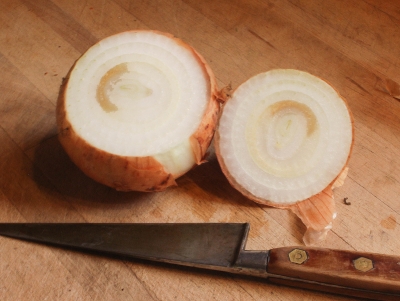
Most plant diseases are caused by fungi rather than bacteria, and fungal diseases are generally easier to control. Even pesticide sprays are not very effective against either onion pathogen. Warm, moist conditions are what have allowed the Pantoea cousins to thrive this year.
Which is not to say that I plan to sit back and watch my onions spoil in future years, or give up growing onions. I already rotate my onion plantings, which would have been my first plan of attack. Although now that I think of it, though, I do often stick a few of various types of onions and excess seedlings here and there around the garden. No more.
The environment can be made less friendly to the bacterium. Mulching the plants would keep the soil cooler. Especially a few weeks before harvest, any watering should cease. Nitrogen fertilization also needs reining in, which would be hard to do in my garden because I fertilize only with compost. Perhaps mulching would cool the soil enough to slow the compost’s mineralization of soluble nitrogen that plants could absorb.
Onion varieties vary in their susceptibility to center rot. Generally, it is the sweet, European type varieties, such as Sweet Spanish, Candy, and Ailsa Craig, that are most susceptible.
Harvest can play a role also. Too early, before leaves have sufficiently dried and flopped down, and the bacteria might be able to edge its way into the bulb. I normally harvest when tops flop down and bulbs easily roll out of the soil (good), then leave them in place to cure in the sun (bad). Next year, I’ll roll them out of the soil and then move them to a shaded, airy place to cure. Or lay them out in the garden so each onion’s leaves covers its neighboring onion’s bulb.
All these measures are worthwhile even if your onions have always looked fine. Center rot bacteria are pretty much ubiquitous, just waiting for good enough conditions to ruin your (and my) onions.
I Clothe The Ground
/6 Comments/in Gardening, Planning, Soil/by Lee ReichSowing My Oats
Whew! Just made it under the wire. Sowing cover crops, that is. (Cover crops are plants grown solely to improve the soil.)
With the vegetable garden still filled to the brim, now overflowing with cabbage, kale, mustard, arugula, lettuce, Chinese cabbages, and radishes, with even corn and peppers still yielding well, where am I going to find room to plant a cover crop? Despite the cornucopia, some plants — the corn, peppers, and other warmth-loving vegetables — are on their way out. As they peter out, it’s too late in the season to sow any more radishes, lettuce, or any of the other cool season crops; there’s not enough time or sunlight for them to mature.
No reason to leave a recently cleared bed of early corn, early beans, or okra bare, so I planted those beds to a cover crop. Problem is that after a certain time of year, there’s not enough time or sunlight for even a cover crop to grow enough to do some good for the soil. My date for that is early October; further south it will be later; further north, earlier.
Right after clearing a bed of spent vegetable plants, I go over it carefully to remove every weed. Then I smooth the ground and give it a thorough watering to give the cover crop plants a quick start. What plants? Oats.
I grow oats as a cover crop because I never till the soil in my vegetable beds. Oats loves the cool weather of fall and early winter, quickly sprouting into a lush, green carpet. By February, though, that lush carpet turns tawny and flops down on the ground, dead. Come spring, I could plant right through that mulch. Or, it could be rolled up with a grass rake, or just pulled off barehanded; removing it speeds soil warming.
Other good cover crops for no-till gardens are barley and, to also add nitrogen to the soil, peas. Gardeners who till their ground usually plant rye grain as a cover crop. It survives winter, then grows with vengeance in spring; hence the need for tillage.
Back to that watered bed. I sprinkle the bed with oat seeds, then top the bed with an inch of compost. Green sprouts poke through that compost blanket in a couple of days or so.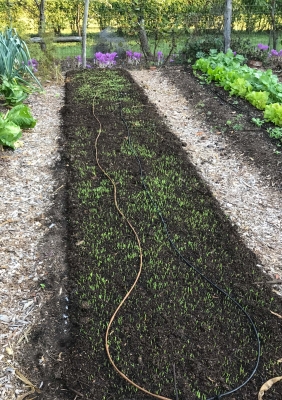
Is It Worth It?
Planting a cover crop in a bed that gets an annual dressing of an inch depth of compost may seem like “carrying coals to Newcastle.” After all, one potential benefit of cover crops are that they add organic matter to the soil. That inch of compost is already organic matter, and plenty of it.
In fact, I have never observed any better growth from a bed that has been cover cropped over one that received only the compost blanket. And for some reason, the cover cropped beds always seem to have more weeds in them in spring — surprising, since a cover crop should be shading or pumping out natural chemicals to suppress weeds! Perhaps some weeds insinuate themselves in fall in among the oat plants, where I can’t see them. My plan, this spring, is to cover some of the cover-cropped beds for a week or so with a black blanket (recycled billboard tarp, available online) which will warm the ground up quicker and snuff out potential weeds.
Even cover crops’ potential benefit of enriching the ground with organic matter doesn’t always pan out, and surely not the way I plant them. Organic matter is largely carbon. Young plants are relatively rich in nitrogen and poor in carbon, a ratio that reverses as the plants age. A young cover crop, then, doesn’t add organic matter to the soil; its excess nitrogen could even contribute to the oxidation and loss of organic matter. Oats planted this time of year grow lushly, but never mature enough to tip the scales in that early ratio of nitrogen and carbon.
(I dive into more depth about cover crops in my book Weedless Gardening.)
Cover Crop Brings Many Benefits
Still, I’m planting a cover crop — for some of its other benefits.
Rain and snow in the coming months can wash nutrients down and out of the soil. The oat roots, as long as they are alive, can suck up those errant nutrients and keep them nearer the surface for next season’s vegetable plants. Cover crops also soften the impact of rain pounding on the soil, preventing erosion.
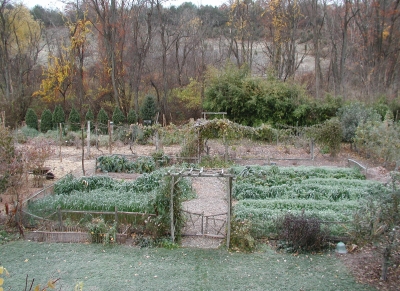
Oats in January
As roots of cover crop plants push through and ramify in the soil, they nudge soil particles around to improve tilth (structure of the soil) making it crumbly, all to the liking of plants. These roots also team up and nourish other organisms, such as fungi, that also improve tilth. Channels of varying size are left in the soil as roots die off and rot away. Such channels provide easy conduits for new roots, as well as for air and water.
And finally, I’m planting cover crops for myself. With green fading from the landscape into reds, yellows and tawny browns, it’s refreshing to look upon the green carpet rather than bare soil in the vegetable garden.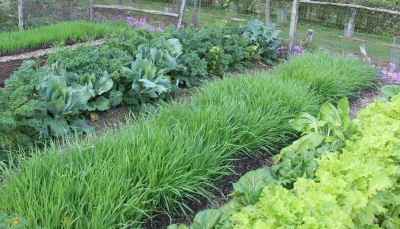
Some Good, Some Bad
/0 Comments/in Flowers, Fruit, Gardening, Pests/by Lee ReichPicking Pecks and Pecks of Peppers
Warm — no, hot — weather going on and on keeps tomatoes, cucumbers, and peppers chugging along, restrained only by diminished sunshine. Still, before real autumn weather rolls in and decimates these warmth-loving plants, it’s time to do some evaluation of this season before it fades into memories that meld with previous seasons.
As usual, there are successes and failures. Good — no, great — are this year’s peppers. I credit the rousing success mostly to My choice of two varieties. The first was an old variety, Sweet Italia, aka Sweet Italian or Italian Sweet. Other varieties are available with similar names; the names are similar, but not the same, as are the fruits.
Sweet Italia has two problems: The seed is hard to find; and the plants flop over under their weight of fruit. Both problems are easily solved: Save seed (Sweet Italia is not a hybrid, so seeds come “true” as long as the plants are sufficiently distant from other pepper varieties); stake the plants. Sweet Italia is especially notable for bearing large and relatively early crops of deliciously sweet red peppers even under northern growing conditions. It’s much, much tastier than Sweet Ace, which is often grown commercially as an early ripening, sweet red pepper.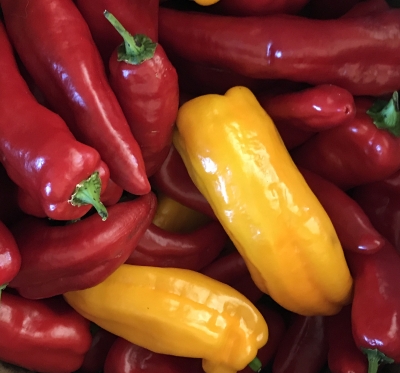
The other pepper variety of note is Escamillo, larger than Sweet Italia and also delicious, in a different way. Escamillo, bred by Johnny’s Selected Seeds, ripens yellow. Like Sweet Italia, Escamillo is a corno di toro, shaped like the horn of a bull.
Blight!!
Balancing my peppery successes are two failures celery and celeriac. Plants looked healthy from the time I sowed seed, indoors in February, until the transplants went out in the garden, in early May. It was downhill from there.
Plants are stunted and their leaves are spotted by disease. The spots are very distinctive, tan with black edges, and angular in outline. The tan areas lacked pycnidia, small, black propagules visible with the naked eye, so the disease is not one of the fungal diseases that afflict celery and celeriac.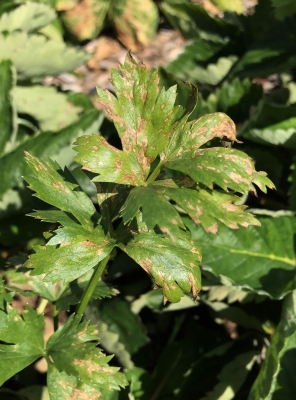
A web search of symptoms and images identified the problem as bacterial blight (Pseudomonas syringae pv. apii). Cool, wet weather exacerbates the condition, and we did have some of that this summer. The fungus can also spend the winter in the soil, which makes a good case for crop rotation, not planting any member of a family of plants in the same place oftener that every 3 years. I did move my celery and celeriac far from previous two locations, though.
I’m pinning the blame on seedling flats that were not sufficiently cleaned. Usually, I just give them a rinse after use; next year they’ll also get a spritzing with alcohol.
Infected seed could also have been the culprit — doubtfully in my garden. The celeriac seed was from a reputable nursery. What’s more, the celery seed comes from my own plants, in the greenhouse. Those plants also self-seed in the greenhouse, and the volunteer plants that come up in the greenhouse look fine. (I thin them out, letting the best ones grow to provide celery all winter, and then self-seed again in spring.)
If infected, seed could be de-contaminated with a hot water treatment, 122°F for 25 minutes. Or with time. Seeds more than two years old don’t carry disease.
Other plans for next year are to be even more thorough with end-of-season cleanup of beds and to rip out of the ground any plants suspected of harboring disease as soon as noticed.
As a last resort, copper sprays, which are approved for organic use, could be applied. I probably won’t do that; it takes the fun out of just popping fresh vegetables into your mouth in among the beds. I have plenty of other good stuff to eat out there.
A Fruitful Season
In fruits, pears have been outstanding this year. Not because of any greenness of my thumb; everybody around here had good crops of pears. Must be something about the weather.
Also outstanding have been grapes. Again, not because of the greenness of my thumb, but because I have so many vines and so many different varieties. Despite weather conducive to diseases, there were — and still are — plenty of good grapes for eating.
Flowers did fine this year, except Lemon Gem marigolds, one flower that I try each year to sow enough of to define the leading edges of the beds in the vegetable garden. They typically germinate poorly for me, but they occasionally self-seed. I couldn’t bear to remove the few that popped up in the main path near the leading edges of the beds. Their general absence makes those few all the more outstanding.
They typically germinate poorly for me, but they occasionally self-seed. I couldn’t bear to remove the few that popped up in the main path near the leading edges of the beds. Their general absence makes those few all the more outstanding.

